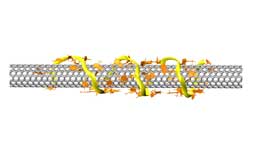Single helices of DNA can be exploited to refine the much-coveted "armchair" shape of carbon nanotubes

DNA, the molecule famous for its ability to store the genetic programs of all living things, is capable of doing other things. In a new paper, researchers from the National Institute of Standards and Technology in the US describe how single helices of DNA can be exploited to refine the much-coveted "armchair" form of carbon nanotubes. Armchair-shaped single-walled carbon nanotubes are important for making "quantum wires" for electricity conduction.
Single-walled carbon nanotubes are usually about a nanometer in diameter, but they may be millions of nanometers long. It's like taking a monoatomic sheet of carbon atoms, arranged in hexagonal patterns, and folding it into a cylinder. However, this curling of the network can be done in many ways, depending on the degree of matching between the edges, from a perfect roll to curled spiral shapes, which have a chiral nature.
Chirality plays an important role in the properties of nanotubes. Most of them behave as semiconductors, but some are metals. One special chiral form - the so-called "armchair-shaped carbon nanotube" - behaves like a pure metal and can form a perfect quantum wire, according to the institute's researchers.
Armchair-shaped carbon nanotubes could bring about a revolution in electrically operated systems, both small and large. Wires composed of these nanotubes are expected to conduct electricity ten times better than copper, at one-sixth the weight and with extremely low energy losses. However, researchers in this field are faced with two obstacles: producing completely pure initial samples of armchair-shaped nanotubes and duplicating them for commercial production. The first challenge, according to the researchers, has so far been an "elusive target".
The separation of nanotubes with a defined chirality begins with their coating in order to make them disperse in the solution, so that they aggregate together into a large mass. A variety of materials are used to initiate this process, including polymers, proteins and DNA. The trick of the scientists from the research institute was to use a DNA coil with a defined affinity for the type of nanotubes. In a previous study, the scientists demonstrated how DNA helices are able to "choose" one shape from among the many semiconducting shapes of carbon nanotubes. In their new paper, the researchers describe how their method makes it possible to develop DNA that "prefers" metallic nanotubes in an armchair configuration over other shapes.
"We believe that what happens is as follows: with the appropriate nanotube, the DNA is wrapped around it in a tortuous manner," explains one of the researchers, "and then the nucleotide bases of the DNA are able to pair with each other in the same way as they do in double DNA -spiral." According to the researchers, "the DNA forms this tight coil around the nanotube." I am fascinated by this mechanism since it is a type of key, and a lock that matches it. The armchair-shaped nanotube is the key that fits into the DNA structure - so we have a kind of molecular recognition."
Once the appropriate nanotubes are wrapped in DNA, normal chemical methods, such as chromatography, can be used to separate them from the mixture with high efficiency.
"Now that we have these pure nanotube samples," explains one of the researchers, "we are able to study the laws of physics underlying these materials and gain further insights into their unique properties.
